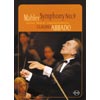Mahler Symphony No 9
There’s no disputing Abbado’s mastery but do visuals really add to the music?
View record and artist detailsRecord and Artist Details
Composer or Director: Gustav Mahler
Genre:
Orchestral
Label: Euroarts
Magazine Review Date: 3/2005
Media Format: Digital Versatile Disc
Media Runtime: 84
Mastering:
Stereo
Catalogue Number: 2054009

Tracks:
| Composition | Artist Credit |
|---|---|
| Symphony No. 9 |
Gustav Mahler, Composer
(Gustav) Mahler Jugendorchester Claudio Abbado, Conductor Gustav Mahler, Composer |
Author: David Gutman
Claudio Abbado is arguably the most distinguished exponent of Mahler’s Ninth currently before the public. Less than maximally emotive but always sensationally well-honed, his interpretation is familiar to UK Prom-goers and record collectors alike.
Where others have tended to impose themselves on Mahler’s invention, Abbado sees his role as that of facilitator to his brilliant young charges. Some will find the results understated, though the first movement is perfectly compatible with Alban Berg’s view of the music as ‘an expression of an exceptional fondness for this Earth, the longing to live in peace on it, to enjoy nature to its depth, before death comes’. The deepest chill is reserved for textural effects like the eerie sul ponticello passage in the violins. With a (suitably refined) sense of corporate purpose spilling over into the briskly ironic middle movements and even the final Adagio, it’s as if the process of leave-taking holds no more terrors. This is lean and mean Mahler, stressing both its classical lineage and positive vibe.
And yet those awkward questions begin to pile up. Can well-planned camerawork give us extra insights into the ‘physical construction’ of music, when, on repeated viewing, any camera movement is likely to feel like a digression? Is it a positive factor or merely a sign of the times that the visual element is taking over?
Abbado’s admirers may be relieved that the maestro of April 2004 seems less gaunt than in the Beethoven cycle he filmed in the old Accademia Nazionale di Santa Cecilia. On the other hand, the Accademia’s new auditorium looks disappointingly bland and anonymous. Nor are the high-resolution images always matched by what we hear. Director Bob Coles zeroes in on the bell plates unexpectedly deployed at the end of the first movement development, only for their sound to be lost in the bass-light, string-dominated mix. There is no bonus documentary, no multi-angle feature to exploit the unique potential of DVD. On the plus side, a rarity in this still-evolving medium, we have full booklet notes from Donald Mitchell.
Where others have tended to impose themselves on Mahler’s invention, Abbado sees his role as that of facilitator to his brilliant young charges. Some will find the results understated, though the first movement is perfectly compatible with Alban Berg’s view of the music as ‘an expression of an exceptional fondness for this Earth, the longing to live in peace on it, to enjoy nature to its depth, before death comes’. The deepest chill is reserved for textural effects like the eerie sul ponticello passage in the violins. With a (suitably refined) sense of corporate purpose spilling over into the briskly ironic middle movements and even the final Adagio, it’s as if the process of leave-taking holds no more terrors. This is lean and mean Mahler, stressing both its classical lineage and positive vibe.
And yet those awkward questions begin to pile up. Can well-planned camerawork give us extra insights into the ‘physical construction’ of music, when, on repeated viewing, any camera movement is likely to feel like a digression? Is it a positive factor or merely a sign of the times that the visual element is taking over?
Abbado’s admirers may be relieved that the maestro of April 2004 seems less gaunt than in the Beethoven cycle he filmed in the old Accademia Nazionale di Santa Cecilia. On the other hand, the Accademia’s new auditorium looks disappointingly bland and anonymous. Nor are the high-resolution images always matched by what we hear. Director Bob Coles zeroes in on the bell plates unexpectedly deployed at the end of the first movement development, only for their sound to be lost in the bass-light, string-dominated mix. There is no bonus documentary, no multi-angle feature to exploit the unique potential of DVD. On the plus side, a rarity in this still-evolving medium, we have full booklet notes from Donald Mitchell.
Discover the world's largest classical music catalogue with Presto Music.

Gramophone Digital Club
- Digital Edition
- Digital Archive
- Reviews Database
- Full website access
From £8.75 / month
Subscribe
Gramophone Full Club
- Print Edition
- Digital Edition
- Digital Archive
- Reviews Database
- Full website access
From £11.00 / month
Subscribe
If you are a library, university or other organisation that would be interested in an institutional subscription to Gramophone please click here for further information.




